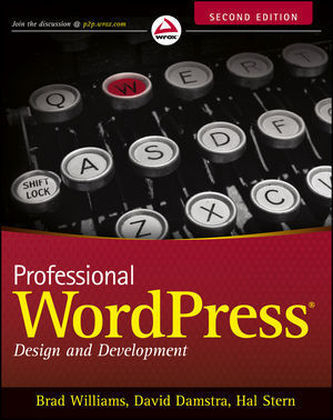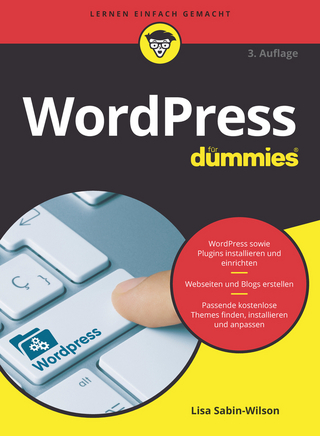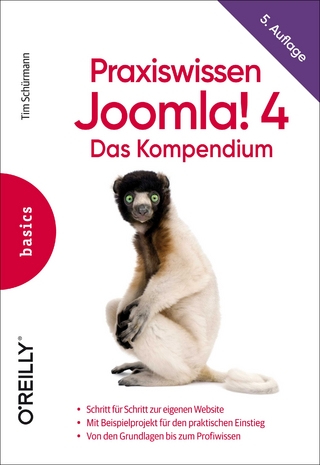
Professional WordPress
Wrox Press (Verlag)
978-1-118-44227-2 (ISBN)
- Titel ist leider vergriffen;
keine Neuauflage - Artikel merken
* Offers an overview of the WordPress system and describes what happens when a WordPress-generated web page is displayed * Demonstrates extending WordPress through plugins and customizing it via themes * Combines a developer view of user experience and optimization with the deployment requirements for performance, security, and measurement * Includes code downloads and code samples from the book's websiteYou'll be hard pressed to find a reliable resource with more advanced content than Professional WordPress, Second Edition!
Brad Williams is the co-founder of WebDevStudios.com, organizes and speaks at WordPress events, and is the coauthor of Professional WordPress Plugin Development. David Damstra is the Vice President of Professional Services for CUAnswers, where his team of developers empowers clients with WordPress. Hal Stern is a VP at Juniper Networks and is the coauthor of Blueprints for High Availability. Wrox Professional guides are written by working developers to address everyday needs. They provide examples, practical solutions, and expert education in new technologies, all designed to help programmers do a better job.
INTRODUCTION xxi CHAPTER 1: FIRST POST 1 What Is WordPress? 1 Popularity of WordPress 3 Current State 3 Intersecting the Community 4 WordPress and the GPL 5 Content and Conversation 6 WordPress as a Content Management System 6 Creating Conversation 7 Getting Started 8 Hosting Options 8 Do It Yourself Installation 10 Finishing Up 17 First-Time Administration 17 First Post 19 Summary 20 CHAPTER 2: CODE OVERVIEW 21 Downloading 21 Download Locations 21 Available Formats 22 Release Archive 22 Directory and File Structure 23 WordPress Configuration 24 wp-config.php File 24 Advanced wp-config Options 26 .htaccess 31 The .maintenance File 35 wp-content User Playground 36 Plugins 36 Themes 37 Uploads and Media Directory 37 Upgrade Directory 38 Custom Directories 38 Summary 39 CHAPTER 3: WORKING WITH WORDPRESS LOCALLY 41 Benefits of Working Locally 41 Typical Deployment Cycle 42 Why So Much Process? 42 Tools for Component Administration 43 Getting Your Development Stack 44 Adding WordPress to the Local Install 45 Configuration Details 46 Managing the Web Server Document Tree 46 Enabling Debug Information 48 Handling Local and Production Database 50 Creating Virtual Local Server Names 50 Local Theme and Plugin Development 53 Deploying Local Changes 53 Summary 55 CHAPTER 4: TOUR OF THE CORE 57 What s in the Core? 57 Using the Core as a Reference 58 Inline Documentation 59 Finding Functions 60 Exploring the Core 62 Deprecated Functions 65 WordPress Codex and Resources 66 What Is the Codex? 66 Using the Codex 66 Function Reference 67 WordPress APIs 69 Codex Controversy 71 Don t Hack the Core! 71 Why Not? 71 Alternatives to Hacking the Core 72 Summary 72 CHAPTER 5: THE LOOP 73 Understanding the Loop 74 From Query Parameters to SQL 75 Understanding Content in WordPress 76 Putting the Loop in Context 76 Flow of the Loop 77 Template Tags 79 Commonly Used Template Tags 80 Tag Parameters 81 Customizing the Loop 81 Using the WP-Query Object 82 Building a Custom Query 83 Adding Paging to a Loop 85 Using query-posts( ) 86 Using get-posts( ) 87 Resetting a Query 88 More Than One Loop 90 Advanced Queries 91 Global Variables 93 Post Data 93 Author Data 94 User Data 95 Environmental Data 95 Global Variables or Template Tags? 96 Working Outside the Loop 97 Summary 100 CHAPTER 6: DATA MANAGEMENT 101 Database Schema 101 Table Details 103 WordPress Content Tables 104 WordPress Taxonomy Tables 105 WordPress Database Class 106 Simple Database Queries 106 Complex Database Operations 108 Dealing with Errors 110 Direct Database Manipulation 111 Summary 114 CHAPTER 7: CUSTOM POST TYPES, CUSTOM TAXONOMIES, AND METADATA 115 Understanding Data in WordPress 115 What Is a Custom Post Type? 116 Register Custom Post Types 116 Setting Post Type Labels 121 Working with Custom Post Types 122 Custom Post Type Template Files 123 Special Post Type Functions 124 WordPress Taxonomy 126 Default Taxonomies 126 Taxonomy Table Structure 126 Understanding Taxonomy Relationships 127 Building Your Own Taxonomies 128 Custom Taxonomy Overview 128 Creating Custom Taxonomies 128 Setting Custom Taxonomy Labels 131 Using Your Custom Taxonomy 132 Metadata 133 What Is Metadata? 134 Adding Metadata 134 Updating Metadata 135 Deleting Metadata 135 Retrieving Metadata 136 Summary 137 CHAPTER 8: PLUGIN DEVELOPMENT 139 Plugin Packaging 140 Creating a Plugin File 140 Creating the Plugin Header 140 Plugin License 141 Activating and Deactivating Functions 142 Internationalization 143 Determining Paths 145 Plugin Security 147 Nonces 147 Data Validation and Sanitization 148 Know Your Hooks: Actions and Filters 151 Actions and Filters 151 Popular Filter Hooks 153 Popular Action Hooks 154 Plugin Settings 156 Saving Plugin Options 156 Array of Options 157 Creating a Menu and Submenus 158 Creating an Options Page 160 WordPress Integration 169 Creating a Meta Box 169 Shortcodes 174 Creating a Widget 175 Creating a Dashboard Widget 179 Creating Custom Tables 180 Uninstalling Your Plugin 182 Creating a Plugin Example 184 Publishing to the Plugin Directory 203 Restrictions 204 Submitting Your Plugin 204 Creating a readme.txt File 204 Setting Up SVN 208 Publishing to the Plugin Directory 209 Releasing a New Version 210 Summary 210 CHAPTER 9: THEME DEVELOPMENT 211 Why Use a Theme? 211 Installing a Theme 212 FTP Installation 212 Theme Installer 213 What Is a Theme? 213 Template Files 214 CSS 214 Images and Assets 214 Plugins 215 Creating Your Own Theme 215 Project Themes vs. Child Themes 215 What to Look for in a Starter Theme 216 Creating Your Own Theme: Getting Started 217 Essential File: Style.css 217 Showing Your Content: Index.php 218 Showing Your Content in Diff erent Ways: Index.php 220 Creating Your Own Theme: DRY 220 Header.php 221 Footer.php 222 Sidebar.php 222 Deviations from the Norm: Conditional Tags 223 Creating Your Own Theme: Content Display 224 Customizing Your Homepage: Front-Page.php 225 Show Your Older Posts by Date: Archive.php 227 Showing Only One Category: Category.php 228 Show Posts of a Specific Tag: Tag.php 230 Other Archival Templates 231 How to Show a Single Post: Single.php 231 Display a Page: Page.php 232 Display Post Attachments: Attachment.php 233 Template Hierarchy 233 Creating Your Own Theme: Additional Files 235 Handle 404 Errors: 404.php 235 Author.php 236 Comments.php 237 Adding Functionality to Your Templates: Functions.php 238 Search.php 240 SearchForm.php 242 Other Files 242 Custom Page Templates 243 When to Use Custom Page Templates 243 How to Use Custom Page Templates 244 Stock Twenty Eleven Page Templates 245 Other Theme Enhancements 246 Menu Management 246 Widget Areas 248 Post Formats 249 Theme Settings 250 Theme Customizer 251 Theme Hierarchy and Child Themes 251 Premium Themes and Other Theme Frameworks 256 Bones Theme 256 Carrington Theme 257 Genesis Theme 257 Hybrid Core Theme 257 Roots 257 StartBox Theme 258 Thematic Theme 258 Summary 258 CHAPTER 10: MULTISITE 259 What Is Multisite? 259 Multisite Terminology 260 Differences 260 Advantages of Multisite 261 Enabling Multisite 261 Working in a Network 262 Network Admin 263 Creating and Managing Sites 263 Working with Users and Roles 264 Themes and Plugins 264 Settings 265 Domain Mapping 265 Coding for Multisite 265 Blog ID 265 Common Functions 266 Creating a New Site 270 Network Admin Menus 274 Multisite Options 276 Users in a Network 282 Super Admins 285 Network Stats 286 Multisite Database Schema 287 Multisite-Specific Tables 287 Site-Specific Tables 287 Summary 288 CHAPTER 11: CONTENT AGGREGATION 289 Getting Noticed 290 Social Media Buttons 291 Feeding WordPress Upstream 292 Buttons, Badges, or Both? 292 Simple Social Networking Badges 293 Collecting External Content 294 Integrating a YouTube Video 295 Integrating Twitter 296 Google Maps 298 Integrating Facebook 299 Generic XML Data 299 Transients 301 Advertising 303 Monetizing Your Site 303 Setting Up Advertising 304 Privacy and History 307 Summary 308 CHAPTER 12: CRAFTING A USER EXPERIENCE 309 User Experience Principles 309 Consistent Navigation 310 Visual Design Elements 312 Making Content Easy to Find 314 Site Load Times 314 Using JavaScript 316 Usability and Usability Testing 316 Structuring Your Information 318 Getting Your Site Found 320 Duplicate Content 321 Trackbacks and Pings 323 Tags and Content Sharing Sites 324 How Web Standards Get Your Data Discovered 324 Semantic HTML 324 Valid HTML 326 Microformats 327 HTML5 329 CSS3 330 Searching Your Own Site 331 Weaknesses of the Default Search 331 Alternatives and Plugins to Help 332 Mobile Access and Responsive Web Design 334 Leave It Alone 334 Lightweight Mobile 335 Responsive Design 335 Summary 336 CHAPTER 13: STATISTICS, SCALABILITY, SECURITY, AND SPAM 337 Statistics Counters 337 AWStats 338 Google Analytics 340 JetPack by WordPress.com 342 Cache Management 343 WordPress System Complexity 344 Web Server Caching and Optimization 345 WordPress Object Caching 347 Transient Caches 347 MySQL Query Cache 348 Load Balancing Your WordPress Site 349 Dealing with Spam 350 Comment Moderation and CAPTCHAs 350 Automating Spam Detection 351 Securing Your WordPress Site 352 Staying Up-to-Date 352 Hiding WordPress Version Information 353 Limit Login Attempts 354 Using Good Passwords 354 Changing Your Table Prefi x 354 Moving Your Confi guration File 354 Moving Your Content Directory 355 Using the Secret Key Feature 355 Forcing SSL on Login and Admin 356 Apache Permissions 356 MySQL Credentials 357 Recommended Security Plugins 357 Using WordPress Roles 360 Subscriber Role 361 Contributor Role 361 Author Role 361 Editor Role 361 Administrator Role 362 Super Admin Role 362 Role Overview 362 Extending Roles 363 Summary 364 CHAPTER 14: WORDPRESS AS A CONTENT MANAGEMENT SYSTEM 365 Defining Content Management 365 Workflow and Delegation 367 User Roles and Delegation 367 Workfl ow 368 Content Organization 370 Theme and Widget Support 370 Homepages 372 Featured Content Pages 373 Content Hierarchy 376 Interactivity Features 379 Forums 379 Forms 379 E-Commerce 380 Other Content Management Systems 380 WordPress Integration 381 Where Not to Use WordPress 381 Summary 382 CHAPTER 15: WORDPRESS IN THE ENTERPRISE 383 Is WordPress Right for Your Enterprise? 383 When WordPress Isn t Right for You 385 Scalability 386 Performance Tuning 386 Caching 388 Regular Maintenance 388 Hardware Scaling 389 Integration with Enterprise Identity Management 391 LDAP and Active Directory 391 OpenID and OAuth 392 Content Integration via Feeds 393 Summary 395 CHAPTER 16: WORDPRESS DEVELOPER COMMUNITY 397 Contributing to WordPress 397 Understanding Trac 398 Working on the Core 401 Submitting Plugins and Themes 402 Documentation 402 Sister Projects 403 BuddyPress 403 bbPress 403 Future Projects 403 Resources 404 Codex 404 Support Forums 404 WordPress Chat 405 Mailing Lists 405 External Resources 406 WordCamp and Meetups 407 WordPress.TV 407 Theme/Plugin Directories 407 WordPress Ideas 407 WordPress Development Updates 408 Make WordPress.org 408 WordPress Podcasts 408 WordPress News Sites 409 Summary 410 INDEX 411
| Sprache | englisch |
|---|---|
| Maße | 189 x 237 mm |
| Gewicht | 770 g |
| Einbandart | Paperback |
| Themenwelt | Informatik ► Web / Internet ► Content Management Systeme |
| ISBN-10 | 1-118-44227-X / 111844227X |
| ISBN-13 | 978-1-118-44227-2 / 9781118442272 |
| Zustand | Neuware |
| Haben Sie eine Frage zum Produkt? |
aus dem Bereich


